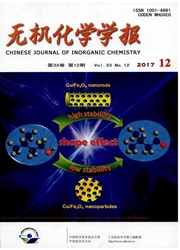

 中文摘要:
中文摘要:
利用异丙基苯硫醚与丁基锂反应后,再依次与羰基铁和碘反应制得了碘桥双核邻异丙硫基苯甲酰基铁配合物[(o-iPrSlC6H4COFe(CO)2I]2,而苯甲硫醚类似的反应却仅得到单核苯硫甲基铁配合物C6H5SCH2Fe(CO)3I。当与亲核试剂作用时,这2个化合物表现出显著不同的反应活性。如双核配合物[(o-iprS)C6H4COFe(CO)21]2与2-吡啶硫醇钠(PySNa)反应得到单核配合物(0-iPrS)C6H4COFe(CO)2(SPy),但单核配合物C6H5SCH2Fe(CO)3I与PySNa反应导致其分解。另一方面,单核配合物C6H5SCH2Fe(CO)3I与三苯基膦(PPh,)反应得到羰基取代配合物C6H5SCH2Fe(C0)2(PPh2)I,但是双核配合物[(o-iPrS)C6H4COFe(CO)2I]2类似的反应却导致其分解.没有获得可表征的化合物。所有新合成的化合物都通过了核磁与红外光谱的表征.它们的结构也获得了X射线单晶衍射的确证.
 英文摘要:
英文摘要:
Reaction of isopropyhhiobenzene with n-BuLi, and subsequently with iron carbonyl and iodine gave a dimeric ortho-isopropylthiobenzoyl iron derivative [(o-iPrS)C6H4COFe(CO)2I]2 through two iodide bridges, while similar reaction of thioanisole only yielded mononuelear phenylthiomethyl iron complex C6HsSCH2Fe(CO)3I. These two complexes show significantly different reactivities upon treatment with various nucleophiles. For example, reaction of [(o-iPrS)C6H4COFe(CO)2I]2 with sodium 2-pyridinethiolate (PySNa) give mononuclear complex (oJPrS) C6H4COFe(CO)2(SPy), while reaction of C6HsSCH2Fe(CO)3I with PySNa results in the decomposition of the starting material. On the other hand, reaction of C6HsSCH2Fe(CO)3I with PPh3 give complex C6HsSCH2Fe(CO)2(PPh3)I, but no characterizable product is obtained from the similar reaction of [(o-IPrS)C6H4COFe(CO)2I]2. All these newly synthesized compounds have been characterized by physico-chemical and spectroscopic methods, and their structures were unambizuouslv determined by X-ray crystallography.
 同期刊论文项目
同期刊论文项目
 同项目期刊论文
同项目期刊论文
 期刊信息
期刊信息
